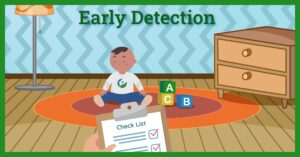
Over the past decade, the growing prevalence of autism spectrum disorder (ASD) has been a cause of concern and speculation for parents across the US. Unlike other conditions, there’s no easy medical test to diagnose ASD. Instead, specialized doctors – typically a developmental pediatrician or a child neurologist – must individually assess each child’s developmental history and behavior to make a diagnosis.
The Centers for Disease Control and Prevention (CDC) points out that while ASD can sometimes be detected at 18 months or younger, most children don’t receive a final diagnosis until they’re much older. In fact, the average age of diagnosis falls just shy of 4 and a half years, based on recent estimates from the CDC. This delay in diagnosing ASD often means that children are unable to get the early help and specialized support they need to meet key developmental milestones, build independence, and improve their core communication skills.
What Are the Early Signs of Autism?
First, it’s important to note that autism affects every child differently – the early signs aren’t always identical. Everyone, regardless of underlying developmental issues, has their own strengths, challenges, and needs. These differences can make early autism detection quite challenging, which is why parents should pay close attention to key developmental milestones.
The CDC lists the following early signs and symptoms as possible indicators of ASD in children:
Delays in Social Communication and Interaction Skills
Early on, parents should be looking out for signs of limited language and nonverbal communication development. This includes things like a lack of consistent eye contact, an inability to move beyond babbling, and an inability to make requests with words.
Communication, socialization, and interpersonal interactions can be challenging for children with ASD. Avoiding eye contact altogether is a common sign of autism (regardless of age), whereas other symptoms are more closely related to developmental delays. Here are other, age-specific signs of autism parents should keep an eye out for:
9 months
-
Does not respond to their name
-
Lack of facial expressions indicating happiness, sadness, anger, and/or surprise
12 months
-
Little or no vocalization (“babbling”)
-
Unable to play simple, interactive games (patty cake, peekaboo, etc.)
-
Uses few or no physical/hand gestures, like waving goodbye or pointing to a favorite toy
15 months
-
Little to no verbal communication, with single-word requests and responses
-
Does not share interests with others and prefers to play alone
18 months
-
Does not point out objects or people to direct your attention to something that interests them
24 months
-
Unable to notice when others are hurt, upset, or sad
-
Limited verbal communication, with only some use of two-word phrases
36 months
-
Does not notice other children or join them in play, preferring to play alone
48 months
-
Does not “play pretend” with others, like imitating superheroes or teachers
-
Does not sing, dance, or act for parents/peers

Restricted or Repetitive Behaviors and Interests
Other signs of autism are less tied to developmental milestones and are present in individuals with ASD at almost every age. Observing one or two of these behaviors or tendencies doesn’t necessarily mean a person has autism; it’s important to embrace and cherish the uniqueness of others, especially children, and to withhold judgement about personal preferences and interests.
Examples of restricted or repetitive behaviors related to ASD may include:
-
Lining up toys or other objects in a particular way, and getting upset when that order is disturbed
-
Repeating words or phrases, often without apparent self-control (sometimes called “echolalia”)
-
Following strict routines when playing with toys, rarely deviating from their habits
-
Hyper-focusing on minor parts or details of an object, like the wheels of a toy car
-
Getting noticeably upset or aggressive about minor changes to routines
-
Flapping hands, rocking compulsively, or spinning in circles frequently (often referred to as “stimming”)
-
Hyper-sensitivity and unusual reactions to how things sound, smell, taste, or feel
-
Tendencies toward self-harm or aggression when overstimulated
Remember, many children with autism will not demonstrate all the signs in the above lists, which is why it’s important to consult a medical professional if you’re concerned about your child’s development.
Next Steps: Developmental Monitoring & Autism Screening
One of the best things parents can do to support their children during key developmental milestones is to pay close attention to their behavior, challenges, and overall growth. Observing how a child plays, learns, speaks, behaves, moves, and communicates can help identify early signs of autism at a younger age. If parents notice milestone delays or concerning behaviors, it’s recommended that they share these observations with their child’s pediatrician and ask for a basic developmental screening.
Since 2019, the American Academy of Pediatrics (AAP) began advocating for universal developmental screening to improve early identification and intervention of autism and other developmental disorders. Under the new guidelines, pediatric clinicians are encouraged to perform standardized screening for children at their 9-, 18-, and 30-month check-ins. The AAP also recommends monitoring children’s development continuously at every well-child visit, with an emphasis on the 4- and 5-year milestone.

If standardized screening uncovers developmental or behavioral issues, pediatricians will refer parents to a medical specialist for a more detailed autism assessment. These assessments are usually administered by a child neurologist or pediatric psychologist, as these specialized providers are the only ones who can give an official ASD diagnosis.
Getting an official ASD diagnosis is the first step toward early intervention. Many autism therapy providers require a diagnosis before treatment can begin, though this often boils down to insurance requirements.
At Applied ABC, we work with parents every step of the way to help them access the services their children need to overcome developmental delays related to autism. Using Applied Behavior Analysis, our therapists provide direct care to children diagnosed with ASD, either at home or in one of our Autism Centers. To learn more, fill out an online ABA Therapy assessment today.
This blog article is part of a series dedicated to Autism Awareness Month. To read the next article in the series, click here!
Sources:



